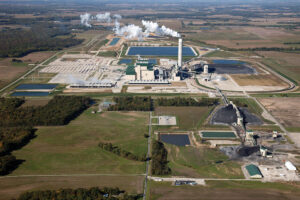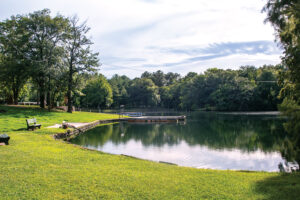 Last month POWER Magazine named Prairie State Energy Campus as one of the top five coal-fired plants in the world. This 1,600-MW mine-mouth plant located in Washington County, Ill., is the largest U.S. coal-fired plant to be built in three decades. The supercritical plant’s state-of-the-art emissions controls result in emissions that are one-fifth the national average for coal-fueled plants.
Last month POWER Magazine named Prairie State Energy Campus as one of the top five coal-fired plants in the world. This 1,600-MW mine-mouth plant located in Washington County, Ill., is the largest U.S. coal-fired plant to be built in three decades. The supercritical plant’s state-of-the-art emissions controls result in emissions that are one-fifth the national average for coal-fueled plants.
The air quality control equipment installed at the plant cost nearly $1 billion. And the plant is very energy efficient. Prairie State’s power plant is built with Super Critical Technology, meaning that it uses coal at a higher temperature and pressure, producing more power with less coal. Using less coal while generating more power results in lower carbon emissions overall.
The plant also improves the overall efficiency and reduces cost and emissions by mining the coal across the street. Unlike coal plants that rail or truck in coal from far away, usually Wyoming, Prairie State transports its coal, via conveyor system, straight from the mine on the same site.
 In addition to being a supercritical power plant, the Prairie State power generating units are equipped with the Best Available Control Technology (BACT). The top four monitored air pollutants are nitrogen oxide (NOx), sulfur dioxide (S02), particulate material (PM) and mercury. Prairie State’s emissions equipment removes 98 percent of NOx, more than 98 percent of SO2, more than 99 percent of PM and more than 95 percent of mercury, making it one of the cleanest power plants in operation today.
In addition to being a supercritical power plant, the Prairie State power generating units are equipped with the Best Available Control Technology (BACT). The top four monitored air pollutants are nitrogen oxide (NOx), sulfur dioxide (S02), particulate material (PM) and mercury. Prairie State’s emissions equipment removes 98 percent of NOx, more than 98 percent of SO2, more than 99 percent of PM and more than 95 percent of mercury, making it one of the cleanest power plants in operation today.
For a little perspective, the average plant in 1970 emitted 4.37 pounds of SO2 per million Btu. In 2011 the average dropped to 0.54 pounds. But today, Prairie State emits just 0.182 pounds of SO2 and already meets projected Cross State Air Pollution Rule regulations set for 2014.
The cost per million Btu is also low at just $1.06. For comparison, natural gas fired generators average about $4.54. Jay Bartlett, President/CEO of Prairie Power, Inc., one of the electric cooperative owners of the plant, says, “Natural gas prices are dropping now because we have found new gas supplies. If you could run your car on natural gas, compared to gasoline, it would be around 88 cents a gallon. If you made the same comparison using the cost of coal and the new Prairie State plant it would be half of that.”
POWER Magazine also pointed out that the on-site 30-year coal reserves would ensure future fuel supplies without transportation costs and would minimize impact on rates caused my market price fluctuations of delivered coal, including transportation.
In planning since 2001, the plant started commercial service in November 2012. Due to permitting legal challenges and construction delays, the plant, like many projects of this size, experienced additional costs. Fortunately, the cost increases were much less than those experienced by similar vintage and scale projects. The original construction contract was amended in 2010 to mitigate some of the construction cost increases. Prairie State certainly didn’t see the cost increases experienced by nuclear construction in the 1970s or the recent integrated gasification combined cycle projects under construction today.
 All but 5 percent of the plant is owned by consumer-owned public power organizations and electric cooperatives across eight states. For example, Prairie Power, Inc. owns 8.22 percent and Southern Illinois Power Cooperative owns 7.9 percent. Each member of the ownership group receives electricity in proportion to its ownership and pays a like percentage of the plant’s ownership and operating costs.
All but 5 percent of the plant is owned by consumer-owned public power organizations and electric cooperatives across eight states. For example, Prairie Power, Inc. owns 8.22 percent and Southern Illinois Power Cooperative owns 7.9 percent. Each member of the ownership group receives electricity in proportion to its ownership and pays a like percentage of the plant’s ownership and operating costs.
Bartlett says, “Between affordable coal and natural gas we have some tremendous advantages in the United States. We are really blessed. With Prairie State our cost of energy is going to be very stable and the future looks really bright. The only negative is we are facing a lot of regulations. We have to have common sense regulations.”
Author of the POWER Magazine article, Dr. Robert Peltier, said, “The ownership group is taking the long view in its investment—the price of natural gas, coal and the cost to transport coal, will steadily rise into the future while Prairie State’s costs are under the owner’s control, unlike most plants. I expect the owners’ investment in Prairie State will pay handsome dividends for many years to come.”








